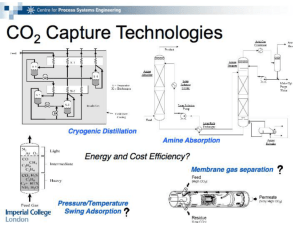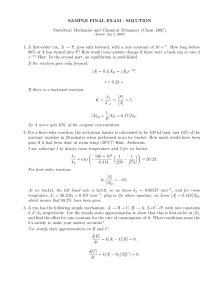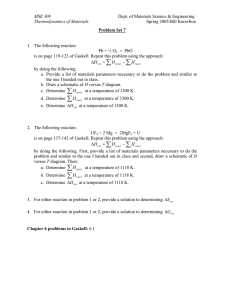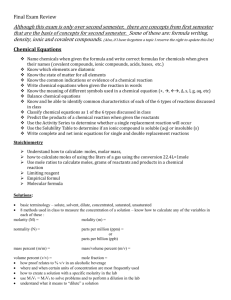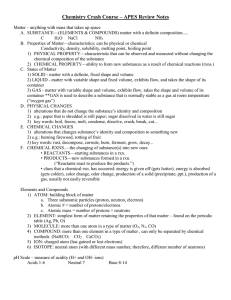Document 13549317
advertisement
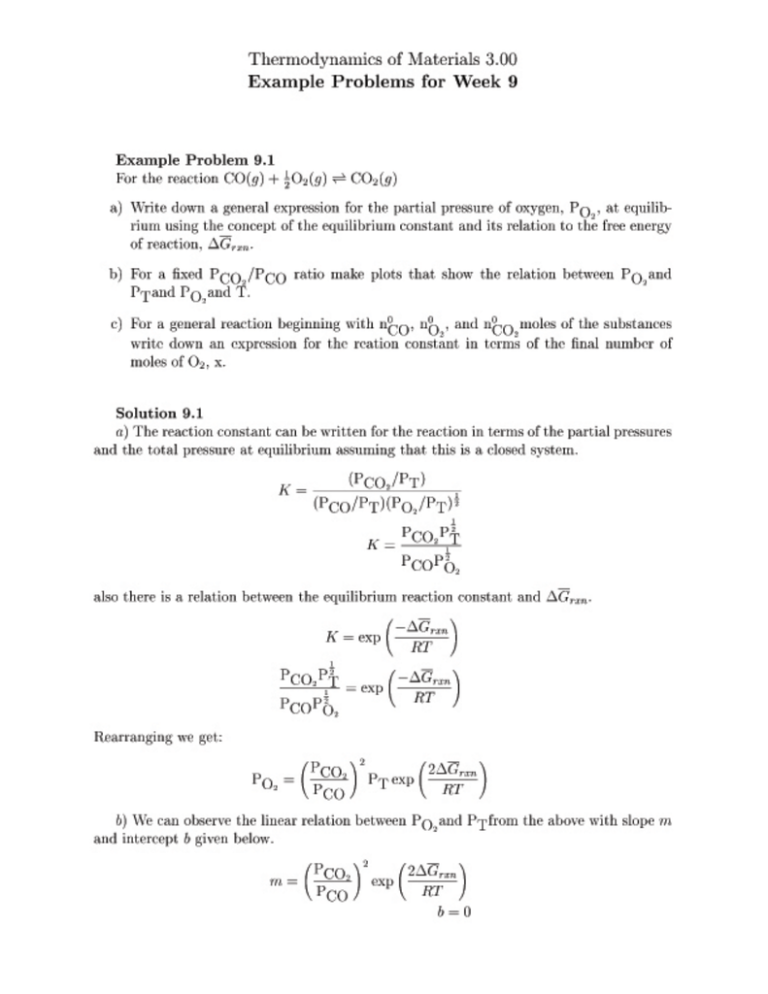
Taking the natural log of both sides of the above we can see the relation between ln PO2 and 1 . P G 1 ln PO2 = 2 ln PCO2 + 2R T CO P In this form the slope is 2 rxn and the intercept 2 ln PCO2 . The slope is negative as CO G < 0. T rxn G R rxn 2 ln PCO2 PC O ( PO2 ) 2 ∆G rxn/R ln PO2 2 2∆G rxn (PPCO2 ) ( exp RT ) CO 1 T PT c) Assuming that the gases act as an ideal gas mixture we can write the equilibrium reaction constant in terms of the mole fractions of each gas. But rst we have to nd out the equilibrium amounts of each substance. The following table shows the knowns to begin with. reaction CO 21 O2 * ) CO2 0 0 initial nCO nO2 n0CO2 change equilibrium x The change in number of moles of oxygen is x ; n0O2 . From this we can calculate the change in the number of moles of CO and CO2 as, dn0CO = 2dn0O2 and dn0CO2 = ;2dn0O2 , respectively. Now we can ll in the rest of the table. 1 O2 * reaction CO CO2 ) 2 0 0 initial nCO nO2 n0CO2 change 2(x - n0O2 ) (x - n0O2 ) -2(x - n0O2 )) equilibrium n0CO+ 2(x - n0O2 ) x n0CO2 -2(x -n0O2 ) The equilibrium constant is written as: n0CO nT 2 K= 0 1 nCO n0O2 ! 2 nT nT n0 n 2 K = 0 CO20 T 1 nCO(nO2 ) 2 1 The total number of moles of gaseous substances will change during a reaction. It is important to use the total number of moles of the gaseous substances at equilibrium for the equilibrium reaction constant, nT = n0CO2 + n0CO + x. (n0CO2 ; 2(x ; n0O2 ))(n0CO2 + n0CO + x) 12 K= (n0CO + 2(x ; n0O2 ))x 21 Example Problem 9.2 Given the molar enthalpies at 298K, H 298 , H 298 , and H 298, the molar entropies at 298K, S 298 , S 298 , and S 298, and the heat capacities, C , C , and C , calculate the equilibrium reaction constant for the following reaction at an arbitrary temperature T. a; a; b; b; c; c; p;a p;b p;c a(g) + b(g) * ) 2c(g) Solution 9.2 The reaction constant has the following relation to the molar gibbs free energy of the reaction, G . rxn ! G K = exp ;RT rxn 2 = nnn ! c a b Now we can formulate G . rxn G G = 2G ; G ; G = 2G 298 ; G 298 ; G 298 + (2G ; G ; G ) rxn rxn c; b; c; c b c a c b Now we can use C to calculate G . p;i i = (2H 298 ; H 298 ; H 298) ;298(2S 298 ; S 298 ; S 298) Z Z Z +(2 C dT ; C dT ; C dT ) 298 298 298 Z C Z C Z C ;T (2 298 T dT ; 298 T dT ; 298 T dT ) G rxn c; b; c; p;c T b; T T c; c; T p;a T p;c p;b T p;a p;b = (2H 298 ; H 298 ; H 298)298(2S 298 ; S 298 ; S 298) Z 2C ; C ; C + (2C ; C ; C )dT ; T dT T G Z rxn c; b; c; T 298 c; T p;c p;a The substitution is straightforward. p;b 298 b; p;c p;a c; p;b

